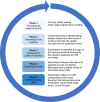Case management in primary care among frequent users of healthcare services with chronic conditions: protocol of a realist synthesis
- PMID: 28871027
- PMCID: PMC5589014
- DOI: 10.1136/bmjopen-2017-017701
Case management in primary care among frequent users of healthcare services with chronic conditions: protocol of a realist synthesis
Abstract
Introduction: A common reason for frequent use of healthcare services is the complex healthcare needs of individuals suffering from multiple chronic conditions, especially in combination with mental health comorbidities and/or social vulnerability. Frequent users (FUs) of healthcare services are more at risk for disability, loss of quality of life and mortality. Case management (CM) is a promising intervention to improve care integration for FU and to reduce healthcare costs. This review aims to develop a middle-range theory explaining how CM in primary care improves outcomes among FU with chronic conditions, for what types of FU and in what circumstances.
Methods and analysis: A realist synthesis (RS) will be conducted between March 2017 and March 2018 to explore the causal mechanisms that underlie CM and how contextual factors influence the link between these causal mechanisms and outcomes. According to RS methodology, five steps will be followed: (1) focusing the scope of the RS; (2) searching for the evidence; (3) appraising the quality of evidence; (4) extracting the data; and (5) synthesising the evidence. Patterns in context-mechanism-outcomes (CMOs) configurations will be identified, within and across identified studies. Analysis of CMO configurations will help confirm, refute, modify or add to the components of our initial rough theory and ultimately produce a refined theory explaining how and why CM interventions in primary care works, in which contexts and for which FU with chronic conditions.
Ethics and dissemination: Research ethics is not required for this review, but publication guidelines on RS will be followed. Based on the review findings, we will develop and disseminate messages tailored to various relevant stakeholder groups. These messages will allow the development of material that provides guidance on the design and the implementation of CM in health organisations.
Trial registration number: Prospero CRD42017057753.
Keywords: case management; chronic conditions; frequent users; interventions.
© Article author(s) (or their employer(s) unless otherwise stated in the text of the article) 2017. All rights reserved. No commercial use is permitted unless otherwise expressly granted.
Conflict of interest statement
Competing interests: None declared.
Figures
References
-
- Department of Health. Caring for people with long term conditions: an education framework for community matrons and case managers. United Kingdom: Department of Health - Long term conditions team, 2006. http://webarchive.nationalarchives.gov.uk/20130107105354/http://www.dh.g... (accessed 21 Jul 2016).
-
- Commission de la réforme des services publics de l'Ontario. Des services publics pour la population ontarienne: cap sur la viabilité et l’excellence. Ottawa: Gouvernement de l’Ontario, 2012.
-
- Wodchis W, 2013. High cost users: driving value with a patient-centered health system. Health Links and Beyond: The Long and Winding Road to Person-Centred Care, Ontario, Canada
Publication types
MeSH terms
LinkOut - more resources
Full Text Sources
Other Literature Sources
Medical


